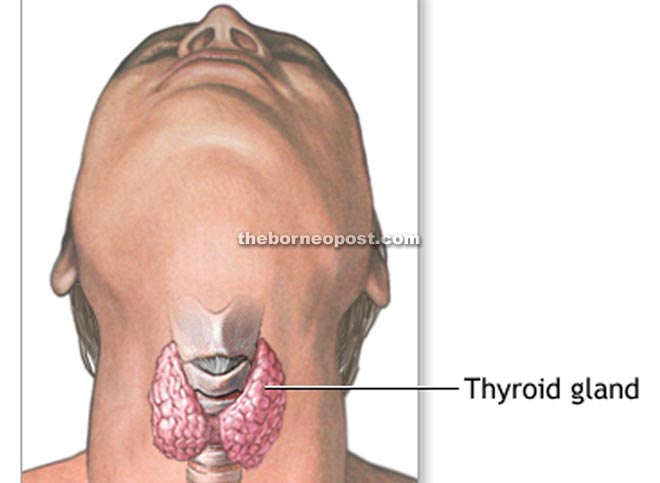
The thyroid gland is a butterfly-shaped endocrine gland in the neck, which releases the hormones instrumental in regulating one’s body metabolism.

Seaweed and seafood are the best sources of iodine – a crucial nutrient for those suffering from underactive thyroid. However, those living in inland remote areas may have difficulty in obtaining this food group.
MIRI: Many people seem to be less aware of the functions of the thyroid gland than other organs in their bodies.
The butterfly-shaped endocrine gland in the neck is vital to one’s health, in that it releases the hormones that help regulate one’s metabolism – the rate of which the body gets energy from food consumed.
However, local general practitioner Dr Noor Eliza Elias has noted that when it comes to complications related to thyroid, the symptoms are not immediately noticeable.
“This could be the reason why not many people know about the functions of the thyroid gland,” she told The Borneo Post in a recent interview.
According to her, hyperthyroidism is regarded as the most common among diseases associated with the gland.
“Hyperthyroidism is a medical condition that is caused by excessive hormones produced by the thyroid gland. Its symptoms include shaky hands, palpitation of the heart, excessive sweating especially on the palms, sensitivity to heat and also ‘staring eyes’ – in which the eyeballs appear to be protruding.
“In some cases, patients also lose weight at an unusual rate.”
Dr Noor Eliza also warned that if left untreated, hyperthyroidism could lead to further complications.
“It has the potential to trigger cardiac shock – a medical condition also known as ‘thyroid crisis’ where the patient could experience a heart attack due to an unusually fast heartbeat.
“This can occur when the level of thyroid hormones (being released) go out of control. As such, it is crucial for patients and their family members to take note of the condition in case of any emergency,” she said.
Still, the doctor assured the public that the disease could be addressed through medication.
Upon diagnosis, she explained that the prescription and dosage of the medication would be determined by the thyroid hormone level in the blood.
“The main aim is to reduce the hormone via drugs, which act to stabilise the hormone level. Treatment duration is usually between one-and-half to two years, depending on cases.
“Once the treatment starts, the level of thyroid hormones would gradually reduce towards stabilisation, and so would the dosage,” she elaborated.
Dr Noor Eliza underlined that it was vital for patients to do follow-ups with their doctors – ideally once every three months.
Nevertheless, she also disclosed that there had been cases where the patients did not respond well to the treatment.
She said under such circumstances, there was another more aggressive treatment – the radiation iodine. However, she said the doctor would only suggest it as the last option – one that needed the patient’s consent as it involved radioactivity.
“Usually we would do our best to avoid undertaking this treatment on any female patient who is at child-bearing age, unless she is really in critical condition. This is because once the patient undergoes the treatment, she needs to postpone any plan to have children until it is completed.”
Notably, she pointed out that based on statistics, hyperthyroidism is said to occur more commonly among women than men.
Dr Noor Eliza also mentioned surgery as the third option, in which doctors would remove the swelling parts of the gland, which according to her, could only be performed if the thyroid functions were stable.
Apart from these options, she said diet formed a key component in the overall treatment of a patient with hyperthyroidism.
She mentioned caffeine-filled food such as coffee should be avoided because caffeine could increase the heart rate, which might make the condition worse.
“Family and friends of the patients should be more observant towards several symptoms leading to the disease such as a change in character, restlessness and short-temper – all of which are caused by the spike in the release of the thyroid hormone,” she said.
“As hyperthyroidism is said to contribute to thinning bones, the patients should maintain adequate intake of calcium and vitamin D in their daily diet to replenish these nutrients that are essential in preventing osteoporosis.”
Additionally, Dr Noor Eliza also highlighted hypothyroidism, or underactive thyroid, which commonly affects women and elderly people living in inland remote areas where iodine-content food like seaweed and certain seafood is least available.
The symptoms include goiter (enlargement of the endocrine gland), slow response to daily activities, a mild gain in bodyweight, fatigue, dry skin and also sensitivity to cold.
“The treatment for hypothyroidism focuses on replacing the thyroid hormone in the body, and one of the natural ways (to do this) is by increasing salt-iodine in the patients’ diet. Hormone replacement, thyroxin, on the other hand, will be given to improve and stabilise the hormone levels.”
However, Dr Noor Eliza said despite the advancement in medical technology, it was unfortunate that there had yet to be any potential cure for hypothyroidism.
“Unlike hyperthyroidism, patients (with hypothyroidism) would need to depend on ongoing medication and a proper diet to stabilise their condition.”
Another condition is euthyroid, which Dr Noor Eliza described as an ‘interesting case’.
“It has virtually no symptoms. It seems that the activities of thyroid hormones are normal, but the swelling of the thyroid gland is obvious.
“Although there is no medication for this condition, surgery would be suggested as an option should the goiter grow larger.”
Dr Noor Eliza then moved the subject to thyroid cancer, which many people might link to the previously stated thyroid diseases.
“In truth, it really depends on individual cases. At first glance, thyroid cancer could be mistaken as goiter, but with less swelling.”
She said at this point, palpation examination would be the initial step to assess the condition.
“Usually the swelling or lump in the neck is firm, but not hard like a stone. While the activities of the thyroid hormone are not similar to any of the previous conditions, a biopsy (removal and examination of tissue sample) is required to determine whether it is cancer.”
Having said this, Dr Noor Eliza clarified that thyroid cancer might not necessarily be caused by other thyroid diseases, explaining that chances were certain circumstances could have triggered the ‘sleeping’ cells to evolve into cancerous ones.
“The bottom-line is regardless of the conditions, annual physical check-ups and blood tests are important for early detection,” she stressed.
